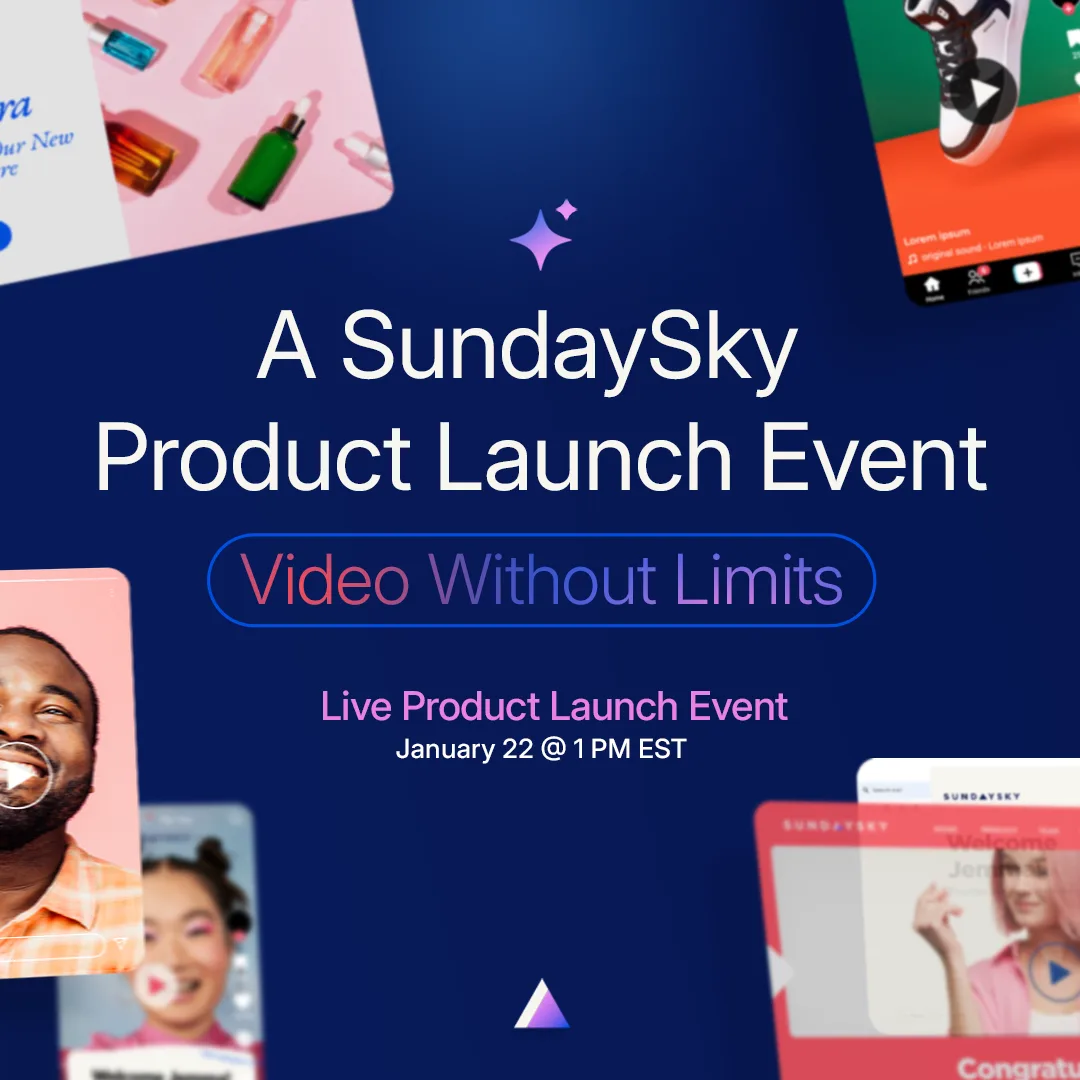9 Steps to Creating an Effective Video Content Strategy
A robust video content strategy is no longer a luxury but a necessity. Video content has become one of the most engaging and effective ways to connect with audiences and ensure that your efforts are targeted, efficient, and aligned with business goals. However, creating high-quality, personalized video content can often be a daunting task, especially if you’re working with limited resources or experience.
This nine-step guide outlines how to create an effective video content strategy, taking you from planning to producing and optimizing videos that reach audiences, build brand awareness, and drive conversions.
Step 1: Understand the Role of Video Content in Your Business Strategy
Before diving into video creation, it’s critical to understand why video is essential to your business strategy. Video content is versatile and can enhance various aspects of your operations, from marketing campaigns to employee training.
Consider the following:
- Brand Awareness and Marketing: Video is one of the most effective ways to engage with potential customers. Short, appealing clips can capture attention, build brand recognition, and drive conversions.

- Product Demonstrations: Complex products often need visual representation. Videos can explain product benefits, functionalities, and customer testimonials better than text or static images.
- Training and Onboarding: Many businesses use video to streamline training processes, let viewers learn at their own pace, and ensure consistency across locations and departments.

- Customer Support: Instructional videos or troubleshooting guides can help customers resolve issues quickly, enhance satisfaction, and reduce support calls.

- Loyalty and Rewards: Personalized video content delivers important renewal information and highlights the value the customer received in the relationship to date, increasing renewal rates and lifting loyalty ratings.

Step 2: Identify Your Target Audience
Understanding your target audience is a crucial part of any video content strategy. Whether your videos are aimed at prospective customers, current clients, employees, or business partners, it’s essential to tailor the content to their unique preferences and needs. Factors like demographics—such as age, gender, location, and income—play a significant role in determining what kind of content will resonate most. Additionally, identifying the specific challenges or pain points your audience faces can help you create videos that provide valuable solutions or insights.
Equally important is understanding where your audience spends their time online. Some may be more active on platforms like YouTube, while others prefer LinkedIn or Instagram. Knowing which platforms they engage with the most will allow you to distribute your videos more effectively. By clearly defining your audience, you can create content that speaks directly to their needs, driving higher engagement and boosting conversion rates.
Step 3: Brainstorm Video Content Ideas for Multiple Business Needs
After you’ve defined your audience, it’s time to start generating video content ideas. A versatile video strategy should address various business needs, from marketing to customer service to internal communications.
Consider the following video content ideas:
- Brand Marketing Videos: Use video to inform and educate viewers about your brand. With compelling visuals and strong storytelling, you can foster a deeper connection with your audience and leave them with a lasting impression.
- Educational Videos: Gain the audience’s trust and demonstrate your expertise by creating engaging educational video content. Video is a proven medium to break down complex ideas, products, or services, so your viewer is more informed.
- Product Tutorials: Demonstrate how to use your product or service in detail, perfect for onboarding customers or providing support. By showing customers (rather than telling), you convey complex information in a digestible format.
- Testimonials: Film customer reviews and success stories for powerful video content ideas that will build trust with customers.
- Account-Based Marketing (ABM): Attract, engage, and acquire your target ABM accounts with highly relevant and personalized video content that moves prospects through the funnel and into your pipeline quickly.
- Training Videos: Streamline employee onboarding or skills development with training videos designed to encourage education and boost compliance.
- Event Marketing Videos: Promote your next event with personalized videos. By tailoring messages to each invite, you make potential attendees feel valued and special, increasing the likelihood of attendance and participation.
For more video content ideas, check out this comprehensive guide to video ideas for business success.
Step 4: Use a Versatile Video Content Creator Tool to Bring Ideas to Life
The next step is choosing the right video content creator. There are a range of video creation platforms available, from beginner-friendly options to more advanced tools. Within the last couple of years, AI video platforms and tools have revolutionized the video creation workflow, empowering businesses of all sizes to generate high-quality content with unprecedented efficiency and scalability.
Look for a video content creator tool that meets your business’s specific needs and allows for scale. Here are some features to consider:
- Ease of Use: Whether you’re a seasoned video editor or a beginner, the tool should be intuitive. AI video editors significantly streamline the video editing process by leveraging AI to quickly perform tasks such as background removal, video resizing, length alteration, and more.
- Templates: Pre-designed templates can speed up video content marketing, training, or social video production. Use AI text-to-video creator tools that employ generative AI to produce videos, assets, or avatars based on text prompts.
- AI-Generated Content: Some platforms offer a holistic approach to video production, covering everything from creation to distribution. Utilizing AI, you can generate fully realized videos complete with themes, animations, on-screen text, voiceovers, assets, and more.
For a deeper understanding, read this list of 5 best practices for evaluating AI-generated video content production tools for your business.
Step 5: Develop a Comprehensive Video Content Marketing Plan
A well-structured video content marketing plan is essential to the success of your video strategy. Without clearly defined objectives and timelines, your efforts can easily lose focus and direction. To build a solid plan, start by setting clear objectives for each video, whether your goal is to boost brand awareness, generate leads, or enhance employee engagement. Next, create a content calendar that schedules your video projects over the coming months, ensuring alignment with key business initiatives and campaigns.
Equally important is the allocation of resources. Identify the team members responsible for creating, executing, and analyzing your video content. Including a data expert can be particularly valuable, as they can help interpret insights and tailor the content for a more personalized and impactful approach. By developing a clear roadmap, every video you produce will serve a specific purpose and seamlessly fit within your overall business strategy.
Step 6: Build Your Video Content Strategy with Storyboarding and Planning Tools
Storyboarding is a crucial yet often overlooked step in creating your video content strategy. By visualizing the flow of the video in advance, you can reduce production hiccups and ensure that the final product aligns with your strategic goals. Even a rough sketch of key scenes can help you plan transitions and ensure that your core messaging is clearly conveyed.
In addition to sketching scenes, writing detailed scripts is essential for outlining narration, dialogue, and actions. This level of preparation keeps production efficient and reduces the need for expensive reshoots. Leveraging planning tools, many of which offer drag-and-drop interfaces, can make the process more collaborative, enabling teams to work together seamlessly. Well-planned videos not only have higher production value but also deliver more focused messages, leading to better audience engagement.
Step 7: Streamline Video Content Production with Editing and Personalization Features
Once the storyboard is complete, the next phase is video content production and editing, where your vision takes shape. The right editing tools can significantly impact the quality and efficiency of your final product. AI-powered video platforms, such as SundaySky, can help streamline the production process, resulting in a 7x increase in production timelines, a 90% reduction in costs, and a 207% return on investment.
With the SundaySky AI Copilot, you can generate complete video scripts in just minutes by using simple text prompts. This eliminates the need for time-consuming storyboarding while ensuring that your videos meet your goals and resonate with viewers. In addition, pre-built templates and creative themes allow anyone—even those without design skills—to produce engaging and polished videos quickly. With a built-in media library powered by Getty, high-quality images, videos, and illustrations can be sourced to significantly reduce editing time.
Video personalization further enhances production efficiency. SundaySky makes it easy to connect data from any source, including HubSpot, Salesforce, Marketo, Google Sheets, and more. With data connectors, you can seamlessly use your data within the SundaySky Platform for video personalization. Personalized video content production with tailored messaging can capture and keep the audience’s attention and create meaningful connections.
“What we’ve seen is that, if a simple image speaks a thousand words, personalized video does exponentially more.” Alice Milligan, Chief Marketing Officer at Morgan Stanley
Step 8: Leverage Analytics and Feedback to Measure Success
An effective video content strategy doesn’t stop once your videos are live. Tracking video performance is critical to understanding their effectiveness. By identifying areas for improvement and suggesting data-driven optimizations, AI video analytics software lets you allocate your resources more effectively, focusing your efforts on what matters—creating content that captivates your audience.
The SundaySky Video Platform offers robust analytics, allowing you to measure key performance indicators (KPIs), including:
- Engagement Metrics: Analyze watch time, click-through rates, and drop-off points throughout the video to find areas of low engagement.
- Scene-by-Scene Performance: Understand which scenes resonate with viewers and which ones lead to the dreaded drop-offs.
Audience Demographics: Gain insights into who’s watching your videos, such as age, location, and interests.
Step 9: Optimize and Adapt Your Video Content for Different Business Needs
Finally, a successful video content strategy requires flexibility. Your video content should evolve to meet the changing needs of your business, audience preferences, and market trends. Optimization doesn’t end with posting the video; instead, continuously adapt your strategy to improve its effectiveness.
Optimize and adapt video content by doing the following:
- Repurpose Content: Convert longer videos into short clips for social media or create a series from a single, longer piece.
- Test and Adapt: Run A/B tests on different versions of the same video to see which performs better.
- Update Content: Keep your videos up to date with the latest information or trends, ensuring that they remain relevant and engaging over time.
By staying agile and constantly improving your videos based on data and audience feedback, you can ensure long-term success.
Conclusion
Creating an effective video content strategy takes thoughtful planning, the right tools, and ongoing optimization. By following these nine steps, you’ll be well on your way to producing videos that not only align with your business objectives but also engage, convert, and retain your target audience. Whether you’re focused on marketing, training, or internal communication, a successful video content strategy will provide your business with the flexibility to grow and adapt in a video-first world.For more expert insights and practical tips on creating high-quality video content, download The 10 Commandments of Video eBook. Whether you’re a seasoned marketer or just starting out, this eBook will equip you with the knowledge and skills you need to succeed in the world of video marketing.






